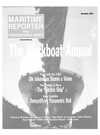
Page 31: of Maritime Reporter Magazine (November 2004)
The Workboat Annual
Read this page in Pdf, Flash or Html5 edition of November 2004 Maritime Reporter Magazine
The Workboat Annual
Coffee Company Investigates MContainer-on-BargeM Service
In 1967 a Brazilian ocean freighter delivered 7,000 sacks of unroasted coffee beans to the cargo docks at the Port of Greater Baton Rouge for Community
Coffee Company. That cargo was the first of many shipped into the capital city port by the company founded in 1919 by Cap Saurage. In 1968 Community built a coffee roasting plant on leased land at the Port of Greater
Baton Rouge and has operated there since. The cargoes of cof- fee beans stopped arriving at the port's dock years ago, however, when shipping product in large containers became more eco- nomical and practical. Since
Baton Rouge is not a container ship port, the containers filled with Community Coffee beans have been shipped into other ports, including the Port of New
Orleans, and then transported to the Baton Rouge roasting plant by trucks. Recently,
Community conducted a test shipment to determine if those containers of beans could be shipped to the port in Baton Rouge by barge rather than moved by truck.
The success of that test, say officials at the Port of
Greater Baton Rouge, now gives Community an addi- tional transportation option and more flexibility in moving cargo, while adding another convert to the growing list of area manufacturers who have experi- enced first-hand the economic and logistic advantages of container-on-barge cargo movement. "Community Coffee Company has had a great rela- tionship with this port for almost four decades," said
Roger Richard, CEO at the Port of Greater Baton
Rouge. Two containers loaded with unroasted beans were moved upriver from the Port of New Orleans by barge and unloaded in Baton Rouge at the port's spe- cial barge container facility at the Inland Rivers Marine
Terminal. The container facility can store up to 250 containers at once and provides loading/unloading/stacking equipment custom-made for barge operations. The IRMT at the port is located off the Intracoastal Waterway and is accessed from the
Mississippi River through the Port Allen Locks.
Osprey Line operates the terminal and currently pro- vides twice-a-week container-on-barge service between Baton Rouge and New Orleans, effectively making the oft-debated but seldom applied short-sea shipping a reality. Communitys GM of supply, Carl
Leonard said that the company presently receives con- tainers of "green coffee" — natural, fresh-picked cof- fee beans — each week that enter the U.S. through the Port of Greater New
Orleans. After U.S.
Customs and other inspec- tions. they are trucked up to the Community Coffee
Roasting Plant in Port
Allen. Most of those con- tainers have been loaded in Brazil, he said, and arrive in New Orleans aboard ocean-going ships.
Some containers of
Mexican coffee also arrived by truck from Laredo, Texas. The green coffee beans are actually the two seeds that form the pits of cherries. The cherry character accounts for the coffee's flavor. Community has been an importer of coffee since the early 1960s. The 85- year-old company is still owned and operated by family descendents of its founder. Cap Saurage.
The company is the largest family owned retail brand of coffee in America. Community is ranked 8th nationally in ground coffee grocery sales according to published IRI market research.
An especially encouraging aspect of the test, said Richard, is that all containerized coffee that now reaches Baton Rouge could be received via barges pushed by towboats plying the
Intracoastal Waterway, meaning means that the
Inland Rivers Terminal could have the potential for a pretty nice coffee business. So far the con- tainer-on-barge terminal in Baton Rouge has attracted local manufacturers who have used it to ship synthetic resins, rice, steel and chemicals, said Johnson. "Adding coffee as a regular cargo would be a nice way to come full circle," he said, "since we used to receive so much coffee here previously. Plus, Community's example could attract other area companies to take a look at the low cost per ton and the higher capacity of barge tows. Just about every type of commodity can be moved by load- ing containers on barges. That's why the service catch- es on quickly with just about everyone who really takes a good look at it." Johnson said.
Now with leak detection
Smart Radar Level
Sensor with Generic
RS485 Output
The first flat array antenna for liquid tank gauging.
This software driven array allows for each sensor to remotely configure itself for the type of product as well as the structural characteristics within each tank. It is completely self-diagnostic and is factory calibrated using a laser interferometer to .1mm. It is designed for the harshest environments and can be provided in a high temperature version to 385°F. It is intrinsically safe with Class 1, Div. 1,
Group D & C approvals. As a smart sensor, all processing calculations and software are resident in the device itself, only a high level generic data output, i.e., RS485 (or others on request) is sent to the cargo control area.
Options: • Multiple alarm set-points • Temperature • PV Pressure * I.G. Pressure • Tank Management Software • Automated draft and trim s
ELECTRONIC MARINE
SYSTEMS, INC. 800 Ferndale Place
Railway, NJ 07065
Call today for more information! 732.382.4344 732.388.5111 fax [email protected] e-mail http://www.emsmarcon.com
Circle 289 on Reader Service Card Circle 306 on Reader Service Card
November 2004 41 [email protected] www.eastproject.it
PATENT PENDING t ©wtogr module
December 1-3,2004
Work Boat Show
New Orleans, Louisiana USA
Booth 1673

 30
30

 32
32
